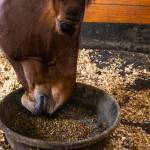Cure for Equine Osteoarthritis Eludes Researchers

Osteoarthritis (OA), the painful deterioration of articular cartilage lining the ends of long bones, continues to be a problem for athletic horses, often requiring rest, surgical or medical treatment, lifelong management, and, all too frequently, retirement from athletic pursuits. Despite decades of intense research in various species, most notably horses and humans, a cure for OA remains elusive.
In a recent effort to put the kibosh on joint pain, an elite team of orthopedists* joined forces and compared the tried-and-true “microfracture” technique with a “bone marrow clot” strategy. In a nutshell:
- Both techniques were designed to treat full-thickness defects or tears in the articular cartilage, meaning the defect reaches the subchondral, or underlying, bone. Cartilage has limited repair capacity, presumably due to the lack of blood supply, as the subchondral bone supplies nutrients to the cartilage layer.
- Microfracture involves creating tiny fissures in the subchondral bone to prompt the release of stem cells and other regenerative factors from bone marrow. Clinical results have varied, from full return to function to continued disability. Failures could be due to compromised subchondral bone following microfracture.
- In lieu of traumatizing the subchondral bone, another approach involves placing a sample of bone marrow aspirate, presumably containing stem cells, directly into the cartilage tears to stimulate healing. In this study, bone marrow cells were harvested from the patient, concentrated using a commercial system, and then placed directly into the cartilage defects.
- Both approaches are minimally invasive using a standard arthroscope.
Researchers found that both techniques achieved similar outcomes a year after surgery. Specifically, magnetic resonance imaging (MRI) revealed that regardless of the approach, all cartilage defects healed with fibrous or fibrocartilaginous tissue rather than normal, healthy articular cartilage.
“The researchers suggested that the concentrated bone marrow aspirate used in this study likely did not contain sufficient stem cells to improve cartilage healing compared to the microfracture technique,” summarized Laura Petroski, B.V.M.S., staff veterinarian for Kentucky Equine Research.
While the researchers modify their approach and continue their work to conquer OA, consider other approaches to minimize the occurrence of joint disease.
“Kentucky Equine Research offers a variety of products to protect joints in healthy horses and decrease inflammation and discomfort in horses already suffering from OA,” shared Petroski.
Learn more about KER•Flex (Glucos-A-Flex in Australia) and Synovate HA, as well as the anti-inflammatory properties of EO•3 proven to benefit horses with OA.
Need help choosing the best supplement and ensuring your horse’s diet is appropriately balanced? Contact a Kentucky Equine Research nutrition consultant today.
*Chu, C.R., L. Fortier, A. Williams, et al. Minimally manipulated bone marrow concentrate compared with microfracture treatment of full-thickness chondral defects: A one-year study in an equine model. Journal of Bone and Joint Surgery. American Volume. 100(2):138-146.








